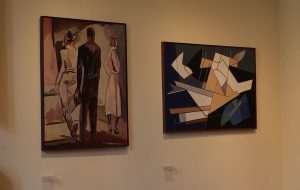The New Casamonti Museum: a Mini MOMA
 A new modern art museum has just been unveiled in downtown Florence.
A new modern art museum has just been unveiled in downtown Florence.
THE ROBERTO CASAMONTI COLLECTION
Internationally renowned art dealer Roberto Casamonti had a number of pieces that he never placed on the market, now on view at this new museum. While Piazza Signoria is filled with tourists and travelers, just a few blocks away, the second floor of Palazzo Bartolini Salimbeni in the quieter, riverside Piazza Santa Trinita has become the place of Florence’s newest modern and contemporary art exhibition.
The display is accessible at no charge through May 31 with a reservation made at least a day in advance by sending an email to prenotazioni@collezionerobertocasamonti.com or by calling 055/602030. Hours are Monday to Sunday 11 – 5 pm, last entrance at 4:30 pm.
Walking into the building, the visitor will find a dimly lit courtyard, but just up the staircase on the right hand side is Casamonti’s private collection of late 19th and 20th century paintings and sculptures up to 1960.
As the guest strolls through the first section of the gallery, which is flooded with natural light, it is apparent that each work is incredibly unique. The collection is undoubtedly curated to match specific themes. Imagery, techniques, colors, and mediums – that range from oils, acrylics, watercolor, pastels, pencil, glass, casein, ink and paper – link the art in each room.
The exhibits were created by Italian and international artists, pioneers in the Macchiaiolo, Futurism, Cubism, Surrealism, Expressionism, Tachisme, Dada, and Pop Art movements to name but a few. Comprising 109 pieces, one room is devoted to Italians such as Giovanni Boldrini, Giovanni Fattori, Giorgio De Chirico, Carlo Carrà and Marino Marini. Another section represents the collective vision of 20th century European artists, including Pablo Picasso, Amadeo Modigliani, Paul Klee, Wassilly Kandinsky and Georges Braque.
The last area focuses on artists closer to the contemporary period: Yves Klein, Alberto Burri (especially known for his experimentation with a wide variety of unconventional materials, including tactile collages with three-dimensional surfaces), Lucio Fontana (with his signature canvases characterized by cuts and slashes), Enrico Baj, Giò Pomodoro, and even two Americans, Louise Nevelson and Andy Warhol.
Nearly all have some kind of connection. French artist Yves Klein developed a pigment, titled International Klein Blue, and helped lead the Nouveau réalisme movement, the predecessor of Pop Art. In Florence, he is represented by one of his “fire paintings,” where he used a torch to negatively outline a figure.
This mini-MOMA collection will be open for one year, and in 2019 a new show will be inaugurated featuring works from the late 1960s to today.
Casamonti, who developed his passion as a child when he accompanied his father Ezio for a sitting at the studio of painter Ottone Rosai (this portrait is part of the museum), believes deeply in the educational value of all kinds of art. (anna rosin & rosanna cirigliano)
